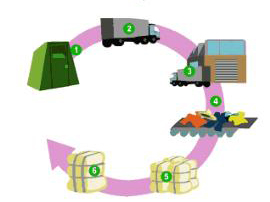
Obstacles
If textile re-processors receive wet or soiled clothes however, these may still end up being disposed of in landfill, as the washing and drying facilities are not present at sorting units.
Process
Clothing and fabric generally consists of composites of cotton (biodegradable material) and synthetic plastics. The textile's composition will affect its durability and method of recycling.
Fiber reclamation mills grade incoming material into type and color. The color sorting means no re-dying has to take place, saving energy and pollutants. The textiles are shredded into "shoddy" fibers and blended with other selected fibers, depending on the intended end use of the recycled yarn. The blended mixture is carded to clean and mix the fibers and spun ready for weaving or knitting. The fibers can also be compressed for mattress production. Textiles sent to the flocking industry are shredded to make filling material for car insulation, roofing felts, loudspeaker cones, panel linings and furniture padding.
For specialized polyester based materials the recycling process is significantly different. The first step is to remove the buttons and zippers then to cut the garments into small pieces. The shredded fabric is then granulated and formed into small pellets. The pellets are broken down polymerized and turned into polyester chips. The chips are melted and spun into new filament fiber used to make new polyester fabrics.[4]
Some companies are creating new pieces of clothing from scraps of old clothes. By combining and making new additions, the eclectic garments are marketed as a type of style. |